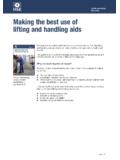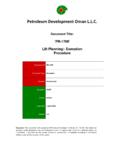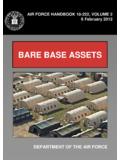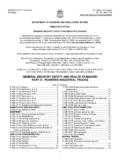Transcription of help with EN1570 - Ambrow Limited
1 SOME help with BRITISH STANDARD BS EN 1570:1999. Safety requirements for lifting tables This is intended to help as a brief guide / overview through some selected parts of the current Scissor Lift table ' or Platform Lift' standard. The headings and numbering when shown follows the precedent in the Official Standard. For brevity and because we choose to concentrate on hydraulic lift tables we have omitted large parts of the Standard that may be important but are not common topics when discussing Manual and Electro Hydraulic Scissor Lift Tables with clients and specifiers. We strongly recommend that you obtain a copy of the current Standard and do not rely on this as a comprehensive or specifically accurate document. Please advise us of any errors you may discover. Where an example of a safety measure is shown it may be one of many. Another solution leading to an equal risk reduction is often acceptable if it provides an equivalent level of safety.
2 Where there are any essential or unusual criteria advise the manufacturer in writing. Consult the competent safety authorities (HSE, Fire, Building Control) and your insurers. We have assumed that only trained and authorised people will operate the lifting tables. 1 Scope BS EN 1570 specifies the safety requirements for lifting tables, power or manually operated including whether stationary or mobile for raising and/or lowering goods and/or persons associated with the movement of goods carried by the lifting table ( not for passenger use), for a vertical travel of up to 3,0. m. It attempts to address all significant hazards applicable to platform lifts when used in foreseen situations and as intended by the manufacturer. EN1570 states many appropriate technical steps to eradicate or lessen risks stemming from these identified significant hazards. EN 1570 does not cover all types of Lifting Tables, this does not mean that lifting tables cannot be made to be suitable, safe and fit for the purpose required and then certified appropriately.
3 Eg. You need to consider what must be done to a Scissor Lift table if you wish to make it suitable for a person of impaired mobility to use it safely in a work environment. You should also look to see if there are other applicable standards Eg. BS6440. When using lift tables for vehicle loading you may wish to also review EN 1398 The Dock Levellers Standard. The following is a list of the more frequently considered applications outside the scope or not covered by BSEN1570: permanently installed lifting tables, serving specific levels of a building and fitted with a car see current definition of a lift car';. permanently installed lifting tables, serving specific levels of a building, not fitted with a car but with a vertical travel of more than 2,000mm;. power operated lifting platforms for persons with impaired mobility;. lifting tables for airport ground equipment, marine use;. mobile elevating work platforms (MEWPS).
4 Vehicle lifts for maintenance;. mobile lifting tables used for fire fighting, used as fork lift trucks, pallet trucks and order pickers;. mobile lifting tables with a travelling speed of more than 1,6 m/s;. rail dependent storage and retrieval equipment;. theatre stage lifts. 2 Normative references Refer to Standard 3 Definitions For the purposes of EN 1570 the following definitions apply: lifting table - load lifting device with a load supporting platform guided throughout its travel ( guided by its own mechanism.). load platform - the part of the lifting table designed to accommodate the working load and/or persons. Fork arms are considered as a load platform for goods only vertical travel - the vertical distance between the highest and the lowest working position for which the lifting table is designed nominal load - the load that the manufacturer has guaranteed that the machine will lift when used in accordance with the instruction handbook guard - part of machine specifically used to provide protection by means of a physical barrier safe by position - condition when a table or part of table is sufficiently shielded from access to avoid any hazard to persons or goods 4 List of hazards - Refer to Standard and EN 1050.
5 5 Safety requirements If people are to travel on the load platform, their load shall be deemed as a minimum of 80 kg. concentrated in an area of 200mm x 200mm for each person, spaced apart at 500mm centres and placed in the most unfavourable position on the platform for stress calculations. Lift tables shall be designed to as a minimum lift half the rated load distributed over half the platform length or lift one third of the rated load distributed over half the platform width. In neither case shall hazardous tilting or deflection take place when used as intended by the manufacturer. Do however remember that unevenly loaded lifts will probably show a measurable level of deflection especially if used towards the upper level of the rated safe working load. Consideration must be given to the different types of loads and the method of loading and unloading the platform in various positions. Eg.: Concentrated loads, point loads, rolling loads, single axle or wheel loads Safeguarding Think crush, trap and shear!
6 Clearances. Generally crushing and shearing shall be avoided by the following minimum gaps between moving parts and between moving and fixed parts: 25mm. for fingers, 50mm. for toes, 100mm. for hands, 120mm. for feet, arms and closed hands, 500mm. for the body. Alternatively other safety measures shall be taken to avoid the operator or any other persons being endangered, : barriers, deflectors, non-mechanically actuated trip devices complying with prEN. 50100, mechanically actuated trip devices complying with category 1 of EN 954-1, multiple controls requiring simultaneous operation or / and screens. Sometimes these examples will not be sufficient by themselves and should be used in conjunction with each other or other equivalent methods. In scissor type lifts there are specified minimum safety gaps between the scissor arms. See Figure 1 in the Standard. When lowering a minimum of free space for the feet shall be provided in accordance with Figure 2 in the Standard to prevent crushing and shearing of feet.
7 Where the machine is fully enclosed with an imperforate rigid guard or is safe by position the minimum gaps are not necessary. If the machine is only partly enclosed by an imperforate rigid guard, then an acceptable alternative must be provided to guard the parts of the machine not enclosed. If a perforate rigid guard is used then this shall comply with the requirements of standards EN 294. and EN 811. If a mechanically actuated trip device (anti-trap bar or sensitive edge) is fitted to the edges of the platform then it is necessary to maintain only the minimum gaps for fingers inside the area safeguarded by the device. These safety devices shall operate so that the moving part causing the hazard comes to a stop before injury is caused. They shall not create another hazard. Where a mechanically actuated trip device ( anti trap bar) is fitted to the underside of the platform, the anti-trap device when actuated shall stop all downward movement of the platform and hold it stopped until the down control has been released, the obstruction removed, the device reset (either manually or automatically) and the down control re-operated.
8 It shall always be possible to raise the platform in order to clear the obstruction. Lifting tables which have a fixed control point on the platform, shall have at least one standing place with an area of 500mm. by 600mm. with a secure handhold for the operator. If outward opening gates are fitted they shall be automatically interlocked with the control system of the vertical travel of the platform (interlocks shall be in accordance with EN 1088). Lifting tables that have a vertical travel of more than 2,0 m shall be fitted with means to prevent persons or goods falling from the platform. For persons these means shall, as a minimum, consist of guard-rails at least 1,100mm high, toe-guards at 150mm high and intermediate guard-rails not further than 500mm from either the guard-rail or toe- guards. If gates or opening parts of the barrier are fitted, they shall be interlocked with the control system so that the platform can be moved only when the barrier is closed.
9 Furthermore outward opening parts shall be interlocked in such a way that these parts can only be opened when the platform is in a clearly defined access position. Unless the lifting table is designed to enable all maintenance work to be carried out when the platform is fully lowered on to mechanical depth stops a manually operated blocking device, also known as a maintenance prop or safety locks, shall be fitted to all lifting tables to allow maintenance work to be carried out below the platform in safety. This device shall be capable of supporting the platform with its rated load, and of being operated from a safe position. Lifting tables which operate in areas to which the public (especially small children) could reasonably be foreseen to have access, shall be enclosed by a rigid guard to prevent the hazard due to the descending platform. Alternatively, a semi-rigid guard ( mesh or material) can be fitted in conjunction with a mechanically actuated trip device / perimeter anti trap bar.
10 The lifting and lowering speeds of the platform shall not exceed 150mm. per second, except where the platform is automatically programme controlled and safe by position . Platforms which are entered by persons shall be fitted with an anti-slip surface ( Tear or Durbar plate, grit surface, anti-slip mats). Emergency lowering devices, where fitted, shall be of the hold-to-run' type. These devices shall be fitted in a safely accessible position and shall not be capable of unauthorized operation. The operator's position shall give the operator a clear view of the platform and its load at all times throughout its travel. All controls shall be of the hold-to-run (deadman) type and be designed to prevent unintentional operation. This does not apply to automatically controlled movements of the lifting table . Where alternative controls are fitted in multiple locations they shall be wired so that only one set can be in use at any one time, excluding the emergency stops.






